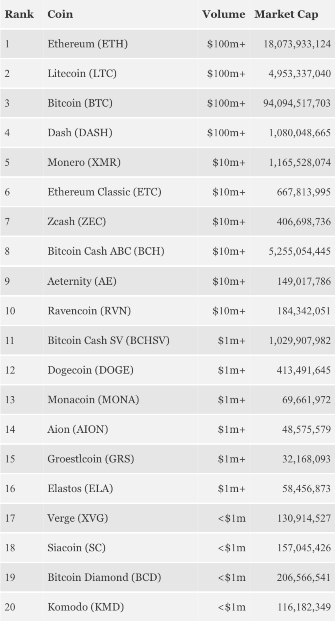The following article originally ran on Forbes April, 26, 2019.
Now that the Crypto Winter is over it is time to take stock. This is the Crypto Spring: time to get busy.
While it is easy to be lured to statements that there are more than 3,000 cryptocurrencies, this is simply not correct. There are roughly 250 meaningful minable, distributed crypto coins. There are lots of dead ones that dont trade but these are unlikely to ever make a comeback.
Ethereum tokens are not currency, they can be equity-like or bond-like or all sorts of permutations of financial instrument, but they are not bitcoin-like currencies unlike Ethereum itself. Tokens, created by Ethereum and other such token-creating blockchains, are different in almost every way to how a bitcoin-like blockchain operates. They should be considered separately from bitcoin and altcoins, in the same way as a Treasury bond or a stock certificate of Softbank should be judged differently from Japanese yen.
When it comes to crypto coins, there are also different types. There are centralized privately maintained coins that are issued privately. These coins have a central control and like a luncheon voucher or an American Express travellers cheque, they have an organization behind them that controls their supply. These coins may be the future, but the crypto environment was spawned by a permission-less, trust-free, distributed concept. These private currencies with their centralized methodologies run diametrically opposed to the whole bitcoin ideal and have an altcoin systemically structured to be the opposite of the original crypto creation, which seems to me, at least, to be problematical.
I choose not to put much trust in the centrally issued coins. You need huge piles of government regulation to even attempt to control the privations of predators in financial services. There is next to none for privately issued cryptocurrency. The only law in play is the so-called law of code, the way distributed crypto coins regulate themselves by code and consensus, which is tremendously powerful when cryptocurrency is not centralized. There is no law of code when the blockchain is privately and centrally controlled.
Where there are resources there are predators and while they strike at the periphery of bitcoin like all the other crypto instruments, none has penetrated the blockchain itself. The trouble with private blockchains, is this safety goes away, just as it does for any currency relying on a central authority for its safety. This might not seem a strong point until you look at the history of currencies and tokens since the beginning of time. History is littered with currencies destroyed or extremely degraded by their issuers and its only very recently that it has been shown that some governments are capable of not being the ultimate predators on their own money. Many believe that this monetary responsibility wont last, but for bitcoin with only its code to protect it, such predations have proven impossible to perpetrate.
Crypto coins following the outline of the bitcoin white paper are the coins I consider the core of the sector and the evidence for that opinion is in the numbers.
If you take the top 100 of all crypto instruments, tokens, private crypto coins, distributed crypto coins, then bitcoin alone is 53% of the value of the whole arena. Bitcoin-like coins, the so-called altcoins, ones you can mine, are 73% of the total market cap of the top 100 instruments.
What is very interesting is that there are so few, about 250, real crypto coins out there and you can easily consider there are only about 30 coins operating at any scale at all.
Here is a snapshot of trading volume totalized from a large cross-section of exchanges as of April 21, 2019:

Its a quiet Easter Sunday but it gives a fair view of the scale of the global crypto market.
The total transaction volume is $1.5 billion.
For me this suggests a huge opportunity. There are 180 global fiat currencies, so there would seem to be room for many cryptocurrencies. By the nature of the code of cryptocurrencies there is plenty of room for diversity. Diversity already exists.Bitcoin is like goldand you might say litecoin is like silver. Monero has more privacy than bitcoin, while Ethereum lets you buy and issue tokens that can operate as distributed programs. As cryptocurrency becomes more used, as they are fungible into bitcoin, the top coins will fill the need for coins in transactions and their price will rise. The value of coins will be determined by their issuance and acceptance. This pyramid of value will be lifted just as it was in the 2017 boom, rising the values of coins and increasing the number of viable small coins as they too gain acceptance. There will be a lot of opportunity for profit as money is created by the demand for money itself and its value is supported by its acceptance and its utility.
In summary, the cryptocurrency market remains tiny and any move towards use and acceptance for payments by cryptocurrency will dramatically expand the market and its currencies valuations. Private coins like Ripple will likely do well but should not be evaluated in the same way. Distributed coins need to be judged on their code and code laws while private coins and tokens need to be judged on the quality of their management.
Both will flourish and soon the next wave of ICOs, now called SCOs. will sweep in, driving more excitement and acceptance and the Crypto Summer will begin.
Clem Chambers is the CEO of private investors websiteADVFN.com




